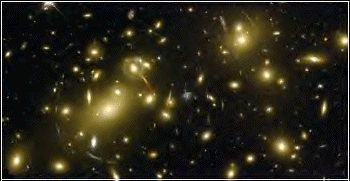Galaxies

Most of space is completely empty. One star can be billions and billions and billions of kilometres away from another star. However, there are parts of space where hundreds of millions of stars are clustered together. This means that stars in these areas are only a few billions of kilometres from each other, instead of being a few billions of billions of kilometres away. These clusters of stars are known as galaxies and come in different shapes and sizes. They usually have a bright centre called the Galactic Central Point, shown as the bright spots glowing in the picture to the left, taken in January 2000 by the Hubble Space Telescope only a few days after it was repaired. The Galactic Central Point is the part of the galaxy where the stars are most closely-packed together.
The Solar System is situated near the edge of the Milky Way galaxy, thirty thousand light years from the Galactic Central Point (about 285,000,000,000,000,000 kilometres away!). There are countless galaxies in the universe. It is impossible for us to count or see even a small fraction of them all. The nearest galaxy to the Milky Way is the Andromeda Galaxy, which is 2.3 million light years away (21,850,000,000,000,000,000 kilometres). This galaxy is similar to the Milky Way in that it is a spiral galaxy, but it is four times bigger than the Milky Way.